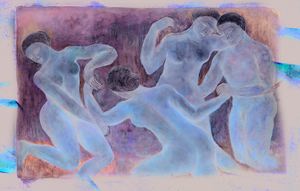“Playing” in an interview with Yulia Lazarevska
The Contemporary Art Museum in Hlybochytska Street closes for an indefinite term after five years of active exhibiting
The fact that it is really hard to earn money on art in our country is growing more and more evident. Proof of this is the fact that the first private Museum of Contemporary Art in Hlybochytska Street suddenly holds the last project of the season and will be closed for an indefinite term after five years of active exhibiting. By the will of destiny, the last project is the simultaneous exhibits of Yulia Lazarevska, “Homo Ludens” (from Latin “Playing Man”), and Mykola Mandrych, “The Beginning.” Thus, it is “The Beginning” (of the museum’s end) and “A Playing Man.” (Probably, if it becomes financially profitably at some point in the future, the museum will open again.)
And so far the museum is full of life, it opens a new music-education Internet radio, arranges film screening, interviews are taking place, and people are talking. In an interview with Yulia Lazarevska the artist shared with our newspaper her own vision of the “genuineness of art,” the exhibit’s concept, her reminiscences, and funny stories from her childhood. Looking at the artist’s works at the exhibit “Homo Ludens” before the interview, I made up a primary “mental project” of the artist’s appearance, what she would tell me, what she is interested in, and strange as it may seem, the image I created almost fully met the following acquaintance with her. Maybe, it was a coincidence, or maybe, it is indeed a correlation between the author and her creative work, in which she put a large share of her emotions, the turmoil of feelings, without which the artist says any work becomes simply a cold and emotionless part of the space.
Art history features numerous stories about the influence of traditional crafts – cult masks of African peoples, “naive” Indian pictures, pointillistic Australian paintings, i.e., the works of authors who never signed their creations – on the creative work of such great artists as Amedeo Modigliani and Pablo Picasso. This anonymity speaks above all not as much about the author’s shyness, as about honoring traditions, using the skills that were passed from teachers to pupils for centuries. The artist is tempted by the historical duration and experience, passed from generation to generation, of crafts like embroidery, ceramics, which artists eagerly involve in the realization of their artistic ideas in painting, photography, and video. Unfortunately, many works of contemporary art have now grounds, traditions, feeling of crystallization, which is typical of traditional art. The works of contemporary, actual, art, which usually retransmit a certain original stylistics and are too much oriented at the indices of the market cost, lack namely this additional dimension of depth.
In Lazarevska’s works you can find certain artistic conditionality, transcendent generalization. Lazarevska turns in her plots to a kind of estrangement from concrete realistic motives, the images of characters, without which no canvas is possible, are maximum generalized like in sacral arts of so-called primitive peoples. Lazarevska’s characters resemble each other, but have distinguishing features too: one of them holds a flute, another one – a trumpet, they are all stylized and schematic, there is only an implication of physical presence. “My characters have no specific location and time. They are everywhere and in no specific place: here and there, in music, dances, and in dreams; they are phantoms and real persons, naked and dressed, considerate and focused on something,” the artist described the characters from her canvases.
Not only does Lazarevska play with techniques, but with meanings, impressions, expectations, and memories, too. For example, in the cycle of portraits the audience should guess through playing the faces they have known for a while: Paul Valery, Friedensreich Hundertwasser, Julio Cortazar, Joseph Brodsky, the personalities who did not become guru teachers in the artist’s creative evolution, but those who through various paths influenced the artist’s inner transformation and establishment. Her special fairytale childhood with crystal-clear reminiscences of the photo sessions arranged by her father during vacations, which later turned into an exiting photo and later video project called “Meander.” Twin sisters in old photos, which were turned into paintings, resemble Alice peeping through the looking-glass and plays with her reflection, making the viewer plunge into the special atmosphere or the mysteriousness of repetitions and groundless allegations that the artist digitalized the photo (with the help of a computer reverse function). This makes one thoroughly examine various age changes depicted in the cycle, a family chronicle, captured by the artistic attention of already grown-up Lazarevska.
“I don’t like double-dyed seriousness,” the artist replied to the “serious” question about her creative credo. Lazarevska in known for her unexpected experiments with techniques and styles, when the viewer who has seen her works, expects to see a photo exhibit, finds himself at an art video screening, or expecting to see paintings, comes to a sculpture installation. Namely playing with “multimedia,” unexpectedness, and spontaneity possesses the creative energy that “prompts the free choice for an artist” to implement that cannot remain unimplemented. To learn more about another dimension of her creative self-expression, the artist invited everyone to the screening of her video works created in cooperation with Mykola Mandrych on Thursday, November 24, at 5 p.m. The admission is free.






